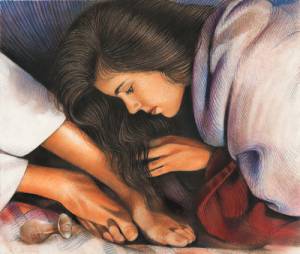The scene is well-known, the story it depicts as well, and the woman character in it is no less famous, could we say. So many works of art, works of fiction and of theological reflection are centred on the subject: Mary Magdalene, the women of Magdala.
The gospel text of this Sunday (11th Sunday of the Year, C – Lk.7:36-50) brings again this scene to our minds and hearts. Much has been said and much more could be said about the woman and about her encounter with the Man of Nazareth, that Teacher so different from all others.
For me, the story could be summariz ed in two verses of the Psalms:
ed in two verses of the Psalms:
“My sacrifice is this broken spirit, you will not scorn this broken heart.” (Ps.51:17)
“The Lord is near to the broken of heart, he helps those whose spirit is crushed.” (Ps.34:18)
More than the broken jar of her perfume, Mary Magdalene brought to Jesus her broken heart – her sorrow for what she had been and… for what she had not been!
Her crushed spirit was filled with regrets, sincere repentance for what her life had been so far; this is what she brings silently before the Man of God.
Her broken heart shows the scars of what the contempt, the arrogance, the selfishness of people have inflicted on her.
All this added to the bitterness of being conscious of her failings – this is what she can place near the feet that she washes and dries with her hair.
She speaks no word, no confession is heard, no self-accusation or even promise of doing better – all is expressed in her silent offering.
Jesus receives it as it is offered, and he is indeed near the woman with a broken heart.
His nearness makes of him her defender against the silent accusation of the self-righteous Pharisee.
Amazingly, Jesus condemns nobody, not even Simon – he, himself, is the one giving the correct answer which condemns him.
It seems that, like some people still today, he has all the answers but… so little compassion!
And, it seems also that our God is a God of compassion… the very compassion that the Man of Nazareth is showing to the woman at his feet.

 Oui, Simon la voit, il l’a vue dès qu’elle a osé mettre les pieds dans cette pièce réservée aux hommes, aux hommes… de bonne réputation! Simon ne veut pas la regarder, l’impureté même, pense-t-il. Mais Jésus l’interpelle et Simon voit la femme, oui, il la voit mais avec ‘les verres teintés’ de ses préjugés de pharisien… mal-pensant!
Oui, Simon la voit, il l’a vue dès qu’elle a osé mettre les pieds dans cette pièce réservée aux hommes, aux hommes… de bonne réputation! Simon ne veut pas la regarder, l’impureté même, pense-t-il. Mais Jésus l’interpelle et Simon voit la femme, oui, il la voit mais avec ‘les verres teintés’ de ses préjugés de pharisien… mal-pensant!